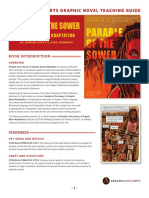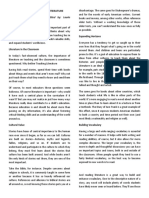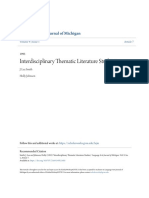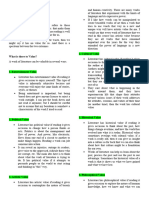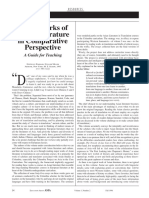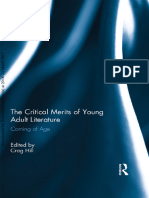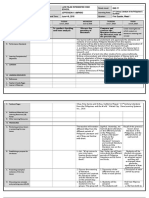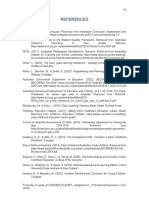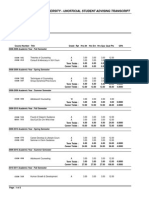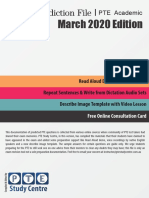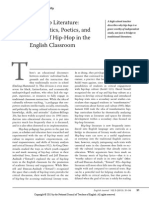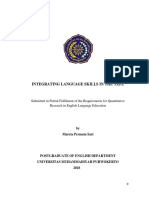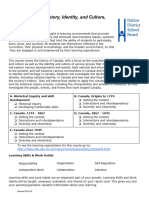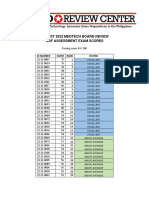Professional Documents
Culture Documents
Sample Annotated Bibliography
Sample Annotated Bibliography
Uploaded by
nicole0 ratings0% found this document useful (0 votes)
81 views4 pagesThis annotated bibliography contains 10 sources that support using literature to teach English language and literature. The sources include books, articles, and studies published between 2015-2017. They address topics like the benefits of teaching literature, using LGBTQ-themed young adult novels, the relationship between language and literature, and how learner background impacts attitudes towards literary study. The annotations describe each source and explain how it relates to using literature in education.
Original Description:
Copyright
© © All Rights Reserved
Available Formats
DOCX, PDF, TXT or read online from Scribd
Share this document
Did you find this document useful?
Is this content inappropriate?
Report this DocumentThis annotated bibliography contains 10 sources that support using literature to teach English language and literature. The sources include books, articles, and studies published between 2015-2017. They address topics like the benefits of teaching literature, using LGBTQ-themed young adult novels, the relationship between language and literature, and how learner background impacts attitudes towards literary study. The annotations describe each source and explain how it relates to using literature in education.
Copyright:
© All Rights Reserved
Available Formats
Download as DOCX, PDF, TXT or read online from Scribd
Download as docx, pdf, or txt
0 ratings0% found this document useful (0 votes)
81 views4 pagesSample Annotated Bibliography
Sample Annotated Bibliography
Uploaded by
nicoleThis annotated bibliography contains 10 sources that support using literature to teach English language and literature. The sources include books, articles, and studies published between 2015-2017. They address topics like the benefits of teaching literature, using LGBTQ-themed young adult novels, the relationship between language and literature, and how learner background impacts attitudes towards literary study. The annotations describe each source and explain how it relates to using literature in education.
Copyright:
© All Rights Reserved
Available Formats
Download as DOCX, PDF, TXT or read online from Scribd
Download as docx, pdf, or txt
You are on page 1of 4
Last Name, First Name Middle Name 10:50-11:50 a.m.
Practical Research 1 Jose Rizal Institute (Orani)
11-HUMSS A Mr. Ezekiel John M. Recto
AN ANNOTATED BIBLIOGRAPHY OF PUBLISHED ARTICLES AND BOOKS THAT SUPPORT [“INSERT
RESEARCH TITLE”]
Author(s) Title Year Publisher Description (Note: This basically
explains what the book or article
you’ve found is about. This part
must be expressed in your own
words.)
1. Alsup, Janet A Case for Teaching 2015 Routledge This book argues why literature
Literature in the must be taught more vigorously in
Secondary School: an education system that privileges
Why Reading Fiction STEM subjects. It enumerates the
Matters in an Age of benefits literature has on students,
Scientific Objectivity identifies the barriers teachers
and Standardization combat to teach literature, and
offers creative teaching solutions
and innovations for students to have
a more enjoyable literary learning
experience.
2. Araya, K., Teaching English 2017 Redie This study investigates the adequacy
Campos, P, Literature in Costa of English as foreign language
González, E., Rican Experimental (EFL) teachers’ training to teach
Marín, G., Bilingual High English and literature or English
Rojas, K. & Schools: EFL through literature.
Sánchez, C. Teachers’ Academic
Training
3. Attridge, Derek The Singularity of 2017 Routledge This book defies the historicity of
Literature literature—that literary classics like
Iliad, Beowulf, or Uncle Tom’s
Cabin are valid cultural reflections
of the societies and time periods
they “represent.” It challenges
teachers, students, readers, and
critics to look into the ethical
importance of literature and to
determine whether there is
something worthy to be called
“literary.”
4. Batchelor, Opening Doors: 2017 The Clearing This article persuades English
Katherin E., Teaching LGBTQ- House language and literature teachers to
Ramos, Maria, themed Young Adult incorporate LGBTQ-themed young
& Neiswander, Literature for an adult literature in the present
Samantha Inclusive Curriculum curriculum to cater to the learning
needs of students who identify
themselves in the LGBTQ spectrum
and those who came from LGBTQ
families.
5. Beach, Richard, Teaching Literature to 2016 Routledge This book offers teachers a variety
Appleman, Adolescents of approaches to help teachers
1
Deborah, & effectively instruct adolescent
Simon, Rob students to read and interpret
literature. It specially recommends
the use of young adult fiction to
draw the adolescent reader. Most
importantly, it gives perspective on
literature learning assessment, a
known obstacle in literature
education.
6. Chun, Dorothy, Technology in 2016 The Modern This article delves into the influence
Kern, Richard, Language Use, Language of technology on linguistic and
& Smith, Bryan Language Teaching, Journal literary expression and maps how
and Language teachers may use technology in
Learning teaching language and literature.
7. Derewianka, Teaching Language in 2016 Oxford This book shows how teachers can
Beverly & Context. Second University Press help their students see how literary
Jones, Pauline Edition. texts reflect real-life language use; it
challenges teachers to use literary
texts that will help students forge an
awareness of language.
8. Fowler, Roger The Languages of 2016 Routledge The author of this book contradicts
Literature: Some (Originally the separation of language and
Linguistic published in literature in most academic
Contributions to 1971) discourse. He refutes that linguistics
Criticism must not be used to interpret
literature. In fact, he asserts that
language and literature are close-
knit and that there is a continuity of
language both inside and outside
literature.
9. Ghazali, Siti Learner Background 2016 Malaysian This study investigates how learner
Nhorliana and their Attitudes Journal of ELT background (i.e. gender,
towards Studying Research socioeconomic status, and location
Literature of school) affects a student’s
attitude toward learning the English
language through literature; its
primary assumption is that students’
proficiency level has a direct
connection to their interest in
studying English by literature.
10 Hall, Geoff Recent Developments 2015 Springer This chapter talks about the
. in Uses of Literature evolution of literary texts that
in Language Teaching readers enjoy and the multimodality
of literary forms technology offers.
It also provides creative insights for
teachers who want to engage second
and foreign language learners in the
study of language through literature.
11 Hayn, Judith Teaching Young 2017 Rowman & This book investigates the
. A., Kaplan, Adult Literature Littlefield popularity of the young adult fiction
Jeffrey S., and Today: Insights, genre and its implications on
Clemmons, Considerations and teaching adolescents and young
Karina R. Perspectives for the adults in the classroom. It explores
Classroom Teacher the different issues today’s young
2
adults imbibe through literature,
such as environmentalism and
gender identity. It also makes
suggestions on how the language
teacher can wield students’ interest
in this genre to teach English and
literature.
12 Kelly, Peter & Snapshots of 2015 International This article compares the language
. Dorf, Hans Language and Journal of and literature teaching styles in
Literature Teaching in Primary, England and Denmark to delve into
Denmark and England Elementary, and the differences of how language and
Early Years literature are taught in both
Education countries and how educational
policies move the linguistic and
literary discourse in the classroom.
13 Leland, Teaching Children’s 2017 Routledge This book gives teachers
. Christine H., Literature: It’s perspective on incorporating
Lewison, Mitzi, Critical! children’s literature into the
& Harste, curriculum in a way that helps hit
Jerome C. the goals of 21st-century language
and literature learning.
14 Ling, Sii, Ling, Types of English 2016 The This study reports that in teaching
. Mee, & Eng, Literature Teaching International literature, teachers favor an
Chen Siew Approaches Preferred Journal of information-based approach over a
by Teachers in Language moral-philosophical approach and
Secondary Schools in Education and paraphrastic approach. The teachers
Miri, Sarawak Applied do not favor this approach because
Linguistics of the students’ backgrounds but
(IJLEAL) because their students would get
higher scores in the standardized
tests when an information-based
approach is used.
15 Mustakim, Siti Teacher’s Approaches 2015 Malaysian This study examines the experiences
. Salina, in Teaching Online Journal and practices of five English as
Mustapha, Literature: of Educational second language (ESL) teachers in
Ramlee, & Observations of ESL Science teaching Contemporary Children’s
Lebar, Othman Classroom Literature to Year 5 students.
16 Ochoa Reading Logs and 2015 How This study explains how reading
. Delarriva O. & Literature Teaching logs can be incorporated in
Basabe, E.A. Models in English literature teaching models for
Language Teacher teachers to discover students’ depth
Education of perception of the world around
them.
17 Short, Mick Exploring the 2018 Routledge This book analyzes the interaction
. Language of Poems, (Originally of readers and literary texts. It
Plays and Prose published in examines how literary texts affect
1997) readers based on how they
comprehend them.
18 Simanowski, Teaching Digital 2015 Transcript This chapter deals with digital
. Roberto Literature literacy’s increased demand as a
result of the growing popularity of
digital literature and the apparent
decline of print literature readership.
It helps teachers adapt to the
3
literature learning situation of the
21st-century classroom.
19 Tehan, Patricia, The Place of 2015 The Reading This study reveals how students feel
. Yuksel, Dogan, Literature in an Matrix: An mixed about the inclusion of
& Inan, Banu English Language International literature in an English language
Teaching Program: Online Journal class. It also highlights that students
What Do Students who are presently enrolled in a
Think About It? literature-infused English class
understand its logic and its
importance in education. It aims to
give teachers some perspective on
how to teach diverse groups of
students based on how they view
literature.
20 Widdowson, Stylistics and the 2014 Routledge This book explains how stylistic
. H.G. Teaching of Literature (Originally analysis can be used to better
published in interpret literature as discourse and
1975) to extend the perceived meaning of
a literary text into the reader’s own
life and experiences.
You might also like
- Parable of The Sower Teaching GuideDocument5 pagesParable of The Sower Teaching GuideAbrams Books100% (16)
- Children and Adolescent Literature SyllabusDocument9 pagesChildren and Adolescent Literature SyllabusSopphia Calope100% (4)
- Loose Parts Leason PlanDocument2 pagesLoose Parts Leason Plandmfitch78100% (4)
- Why Do We Teach LiteratureDocument3 pagesWhy Do We Teach LiteratureGedie RocamoraNo ratings yet
- SPEC 111-E - Teaching and Assessment of Literature Studies (Handout)Document12 pagesSPEC 111-E - Teaching and Assessment of Literature Studies (Handout)Irene BerteNo ratings yet
- Children's Literature History, Literature in The LivesDocument1 pageChildren's Literature History, Literature in The LivesJoshua LagonoyNo ratings yet
- 2parungao Callueng Clarin Free Critical Paradigm 1Document6 pages2parungao Callueng Clarin Free Critical Paradigm 1Irish NomorosaNo ratings yet
- Teaching LiteratureDocument20 pagesTeaching LiteratureZyra Yvonne MangligotNo ratings yet
- Research ProposalDocument6 pagesResearch Proposalapi-517882844No ratings yet
- Aug 28 - Sept 1Document3 pagesAug 28 - Sept 1Sheryl PanesNo ratings yet
- 21ST Century Literature Q1 Week 5Document4 pages21ST Century Literature Q1 Week 5moanaNo ratings yet
- Children and Adolescent LiteratureDocument3 pagesChildren and Adolescent LiteratureMaiccah AcostaNo ratings yet
- Teaching Literature AppreciationDocument6 pagesTeaching Literature AppreciationRalph Samuel VillarealNo ratings yet
- DLL in 21st CenturyDocument4 pagesDLL in 21st CenturyJeanelle Arnellei Lo100% (1)
- Literature 1Document4 pagesLiterature 1Clarisse MacalintalNo ratings yet
- Literature As A Media/Source in Language Learning: by Visa RanicoDocument6 pagesLiterature As A Media/Source in Language Learning: by Visa RanicoVisa RanicoNo ratings yet
- The Importance of Teaching LiteratureDocument2 pagesThe Importance of Teaching LiteratureJoselle ReyesNo ratings yet
- Interdisciplinary Thematic Literature Studies: Language Arts Journal of MichiganDocument15 pagesInterdisciplinary Thematic Literature Studies: Language Arts Journal of Michiganmimo72No ratings yet
- DLL 21st Century Lit.Document4 pagesDLL 21st Century Lit.Edmark Manlangit BalceNo ratings yet
- Similar Literary Quality Demystifying THDocument11 pagesSimilar Literary Quality Demystifying THAPURBA SAHUNo ratings yet
- KoyaCF2001 Teaching Literature AppreciationDocument7 pagesKoyaCF2001 Teaching Literature AppreciationCherise SpiteriNo ratings yet
- 21ST Century Literature Q1 Week 5Document4 pages21ST Century Literature Q1 Week 5Naj CumlaNo ratings yet
- Chapter 1-6-7Document10 pagesChapter 1-6-7debater.chorizo-0yNo ratings yet
- Cabuena Digital CompilationDocument40 pagesCabuena Digital CompilationKiah Marie CabuenaNo ratings yet
- Context of Text DevelopmentDocument5 pagesContext of Text Developmentimee enriquezNo ratings yet
- RUNNING HEAD: Literature ProjectDocument11 pagesRUNNING HEAD: Literature Projectapi-434818140No ratings yet
- Love YouDocument5 pagesLove YouVinch QuerubinNo ratings yet
- Macalintal Clarisse E.-BEED 2-D-Literature 1-ACTIVITY 1Document4 pagesMacalintal Clarisse E.-BEED 2-D-Literature 1-ACTIVITY 1Clarisse MacalintalNo ratings yet
- Q2Document5 pagesQ2haydeeNo ratings yet
- DLL 21st Century Lit - CompressDocument4 pagesDLL 21st Century Lit - CompressESTEPHANIE TUMAGANNo ratings yet
- Kent Leo Estaura, Maed: InstructorDocument70 pagesKent Leo Estaura, Maed: InstructorChristen Honely DadangNo ratings yet
- Value of LiteraturetextDocument6 pagesValue of LiteraturetextRosemary Dawn FegideroNo ratings yet
- 21st Century Januaary 23& 25Document5 pages21st Century Januaary 23& 25Mari LouNo ratings yet
- Zuasola, Iriz G. Beed-Gen - Ed. Iii AS15-Eng 2: The Importance of Children's LiteratureDocument4 pagesZuasola, Iriz G. Beed-Gen - Ed. Iii AS15-Eng 2: The Importance of Children's LiteratureIriz Gonzaga ZuasolaNo ratings yet
- Masterworks of Asian Literature in Comparative Perspective A Guide For TeachingDocument2 pagesMasterworks of Asian Literature in Comparative Perspective A Guide For Teachingmanuela1d66No ratings yet
- Using Literature in Elt Focus PaperDocument5 pagesUsing Literature in Elt Focus Paperfulencita.11caroNo ratings yet
- Grade 1 To 12 Daily Lesson Plan School GDocument3 pagesGrade 1 To 12 Daily Lesson Plan School GbinuaangelicaNo ratings yet
- 21st Century Januaary 23& 25Document5 pages21st Century Januaary 23& 25Mari Lou50% (2)
- Reviewer For Literary CriticismDocument11 pagesReviewer For Literary CriticismReg RamboyongNo ratings yet
- Sed 4200 Professional Writing 4Document3 pagesSed 4200 Professional Writing 4api-643520743No ratings yet
- SyllabusDocument34 pagesSyllabusAkashleena SarkarNo ratings yet
- english-american-litDocument7 pagesenglish-american-litjas37004No ratings yet
- The Critical Merits of YA LiteratureDocument220 pagesThe Critical Merits of YA LiteratureEvangelia Dimitropoulaki100% (1)
- Week 1 21ST - 014324Document3 pagesWeek 1 21ST - 014324Jennifer AlbaradoNo ratings yet
- The Use of Literature in Language ClassroomDocument6 pagesThe Use of Literature in Language ClassroomFaith Ramos LaraseNo ratings yet
- In Defense of Graphic Novels: Kathryn Strong HansenDocument7 pagesIn Defense of Graphic Novels: Kathryn Strong Hansenroxy_crestfallenNo ratings yet
- EEd 19 LP 1 PISCOSDocument9 pagesEEd 19 LP 1 PISCOSmae.serafinnNo ratings yet
- Literature in The Language ClassroomDocument6 pagesLiterature in The Language ClassroomInternet GhoulNo ratings yet
- Summary Chapter IvDocument3 pagesSummary Chapter IvBetseba SilalahiNo ratings yet
- DLL 21ST Week 1Document4 pagesDLL 21ST Week 1Charlene Aguilar Javin100% (1)
- DLP March 21Document5 pagesDLP March 21Glydel Anne C. LincalioNo ratings yet
- Life EAP Level 6 Listening U1 NotesDocument3 pagesLife EAP Level 6 Listening U1 NotesOsama CanaanNo ratings yet
- Tucker Liberating Students Through Reader-Response Magnifying ClassDocument8 pagesTucker Liberating Students Through Reader-Response Magnifying ClassemysamehNo ratings yet
- DLL WEEK 6 July 23 27 2018Document3 pagesDLL WEEK 6 July 23 27 2018Danilo AyongNo ratings yet
- Daily-Lesson-Log - 3M JJG 11Document5 pagesDaily-Lesson-Log - 3M JJG 11John Rey Macasieb100% (1)
- Teaching Guide 21st Century LitDocument7 pagesTeaching Guide 21st Century LitMary Joan PenosaNo ratings yet
- Artículo - Nancy B. Sardone - Teaching Classic Literature With Comic Books and Virtual Lit TripsDocument5 pagesArtículo - Nancy B. Sardone - Teaching Classic Literature With Comic Books and Virtual Lit TripsJose Miguel Lizano SeguraNo ratings yet
- The Significance of Using Literature in The EFL ClassroomDocument5 pagesThe Significance of Using Literature in The EFL ClassroomPsychology and Education: A Multidisciplinary JournalNo ratings yet
- Daily Lesson PlanDocument8 pagesDaily Lesson PlanShinki MirikaNo ratings yet
- Support System Definition & Meaning Britannica DictionaryDocument1 pageSupport System Definition & Meaning Britannica DictionarynicoleNo ratings yet
- The Cruel Prince (The Folk of The Air) Holly Black 9781471407277Document1 pageThe Cruel Prince (The Folk of The Air) Holly Black 9781471407277nicoleNo ratings yet
- Production and Financial StabilityDocument14 pagesProduction and Financial StabilitynicoleNo ratings yet
- David Fincher - Google SearchDocument1 pageDavid Fincher - Google SearchnicoleNo ratings yet
- 03 Scandalous A몭air: Download nowDocument53 pages03 Scandalous A몭air: Download nownicoleNo ratings yet
- ReferencesDocument2 pagesReferencesapi-682237653No ratings yet
- Malone TranscriptDocument3 pagesMalone Transcriptapi-286328619No ratings yet
- Development of Financial Accounting Achievement Test For Assessment of Senior Secondary School Students in Imo StateDocument13 pagesDevelopment of Financial Accounting Achievement Test For Assessment of Senior Secondary School Students in Imo StateSoulla Gabrielle GordonNo ratings yet
- PTE March Prediction 2020 PDFDocument134 pagesPTE March Prediction 2020 PDFKimberlyNo ratings yet
- Speech CovidDocument3 pagesSpeech CovidAnanda SaviraNo ratings yet
- Ej 1025 HipDocument6 pagesEj 1025 Hipapi-269830561No ratings yet
- Abolishment of School Fees in TanzaniaDocument56 pagesAbolishment of School Fees in TanzaniaJean-Louis KayitenkoreNo ratings yet
- ENG4C Unit Plan 1Document6 pagesENG4C Unit Plan 1Danika Barker100% (2)
- Sample Action Research Proposal PDFDocument23 pagesSample Action Research Proposal PDFGels Genova0% (1)
- Approach, Method, Technique, and StrategyDocument10 pagesApproach, Method, Technique, and StrategySalsha NabilaNo ratings yet
- Trainers Methodology (TM) Level 1: Portfolio inDocument27 pagesTrainers Methodology (TM) Level 1: Portfolio inbob guintoNo ratings yet
- Article 5 PDGS6102Document27 pagesArticle 5 PDGS6102ainul murizaNo ratings yet
- PKBLDocument2 pagesPKBLRama MaulidinNo ratings yet
- Integrating Language Skills in The Tefl PDFDocument19 pagesIntegrating Language Skills in The Tefl PDFKamran RajaNo ratings yet
- CHI4U Canadian History, Identity, and Culture, Grade 12Document2 pagesCHI4U Canadian History, Identity, and Culture, Grade 12Jamie MeyerNo ratings yet
- College Preparedness SURVEY QUESTIONNAIREDocument2 pagesCollege Preparedness SURVEY QUESTIONNAIREGlen Jay Dela CruzNo ratings yet
- MSBM Programmes Brochure (2015)Document49 pagesMSBM Programmes Brochure (2015)OluwatobiAdewaleNo ratings yet
- ACE LEPT Narrative Report July 8-9, 2023Document4 pagesACE LEPT Narrative Report July 8-9, 2023Edwin Breva Jr.No ratings yet
- OBF Assessment Exam ResultsDocument3 pagesOBF Assessment Exam Resultsnathanmrrk pacayNo ratings yet
- Taylor Anne Weaver: EducationDocument2 pagesTaylor Anne Weaver: EducationTaylorNo ratings yet
- (123doc) - Some-Factors-Influencing-Student-Satisfaction-In-E-Learning-A-Study-Of-University-Students-In-Ho-Chi-Minh-City-Viet-Nam PDFDocument85 pages(123doc) - Some-Factors-Influencing-Student-Satisfaction-In-E-Learning-A-Study-Of-University-Students-In-Ho-Chi-Minh-City-Viet-Nam PDFPhương NgânNo ratings yet
- Core Values and Virtuesof ProfessionalDocument1 pageCore Values and Virtuesof Professionaljohncarlo ramosNo ratings yet
- Press Release For MarcusDocument2 pagesPress Release For Marcusapi-609078185No ratings yet
- D Sellenriek InterviewDocument2 pagesD Sellenriek Interviewapi-103416442No ratings yet
- Maksim Paskalev CVDocument2 pagesMaksim Paskalev CVMax Paskalev VynyNo ratings yet
- Factors For Teachers' Increased ProductivityDocument26 pagesFactors For Teachers' Increased ProductivityEnvoy Tolulope Joseph LeviteNo ratings yet
- Lesson Plan - SGDocument2 pagesLesson Plan - SGapi-339156741No ratings yet
- POY NewDocument18 pagesPOY NewShanessa FennerNo ratings yet
- Ubiquitous Computing PaperDocument141 pagesUbiquitous Computing PaperMohaned ElfandiNo ratings yet
